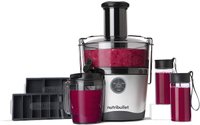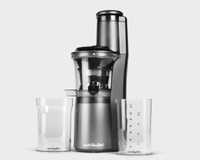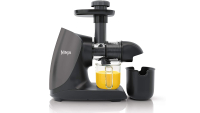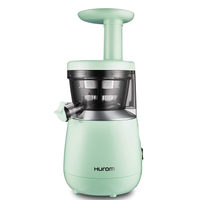All of the juicers included in this guide have been thoroughly reviewed by members of our reviews team, so you can not only trust that we have had hands-on experience of each one, but you can click through to read complete reviews, and learn more about each juicer’s benefits and drawbacks. We tested each juicer for the quality of the results: a consistently clean juice is what you expect, after all. However, our testing team also looked at functionality, ease of use and special features, plus - of course - how easy the juicers were to take apart, clean and put back together again, since we know this can be time-consuming. Juicers can easily rival the best blenders when it comes to creating morning drinks, with the added ability to remove unwanted pulp and fibers from a range of ingredients. These are our favorites.
Latest juicer deals
The best juicers of 2023, as tested by our team
Why you should buy it: Juice quality is unrivalled; handles soft and hard ingredients with ease. Why we love it: ‘I found that the Kuvings EVO820 produces the cleanest, purest juice with the included standard strainer. Even better, it can easily handle soft and hard fruits alike,’ reports our tester Camryn Rabideau. ‘You also get smoothie and sorbet strainers in the box, expanding what this machine is capable of.’ One of the hassles with masticating juicers is that you have to cut fruit into small chunks, but Kuvings solves that with its wider 3.22in feeding chute. ‘While I still needed to cut fruit and remove seeds, I could fit bigger chunks in, so get results faster, really useful when I was making drinks for the whole family,’ says Camryn. ‘The operation is really easy, too: turn the machine on and push the fruit through the machine.’ Water can be run through the machine for a quick rinse between drinks, but the parts otherwise have to be disassembled (an easy job) and hand-washed. ‘Price is the main issue for this juicer, but if you want the absolute best-quality juice, the Kuvings Whole Slow Juicer EVO820 is for you,’ concludes Camryn. Our full Kuvings EVO820 review has more details Why you should buy it: Powerful; wide chute makes it easy to use. Why we love it: The NutriBullet NBJ50200 Juicer Pro is the best juicer for beginners: it comes with everything you need, including a freezer tray, a pitcher with froth separator, two glass to-go bottles, and a cleaner brush and recipe manual. I found it a powerful option with a 1000-watt motor. Its wide chute can fit plenty of fruits and vegetables without the need to chop. The pitcher can be sealed to make juice ahead of when you want to drink it, and it’s large enough to make family-sized drinks. When I tested it I was impressed by the two speeds and the recipe book that walked me through everything I needed to know to make delicious juices. The Nutribullet was also easy to clean because most of the parts can go in the dishwasher. Good to know: The Nutribullet has a medium capacity. I found that with larger or less wet items the pulp basket filled up quite fast. It needs to be emptied a few times if you plan on making juice for more than two people, so consider something with a chute for non-stop juicing. Our NutriBullet Juicer Pro review has more details. Why you should buy it: Great for single-serve juicing; compact. Why we love it: The Hurom HP Slow Juicer comes in a few sweet colors including mint, pink and white, and its designed with compactness in mind, so will likely fit comfortably in your kitchen cabinet, though you may have to separate the juicer portion from the base for low-sitting shelves. Slow juicers are known for low-pressure and prolonged juicing. With a 43 RPM, our Ecommerce Editor Jaclyn Turner found it delivered juice fast and in generous volumes compared to other juicers on the market, and it left us with a very dry pulp, maximizing the flavor and nutrients that made it into our cups. Good to know: ‘The chute could have been wider – I found that it would not fit an entire apple in testing, which means more food prep and effort. Cleaning (as with most juicers) was also a hassle, but I enjoyed that this juicer can also make nut milk and even ice cream. I think it’s a great choice when you consider that it’s not the most expensive option in Hurom’s line up.’ Our Hurom HP Slow Juicer review has more details. Why you should buy it: A blender and a juicer in one. Why we love it: It has removable attachments for blending and juicing, and you can use the blender pitcher to catch all the juice from the juicer spout. You could then even blend some ice or fresh fruit into your juice for delicious drinks and frozen cocktails. While I was very impressed by the blending modes on the Breville The 3x Bluicer, its the juicing capabilities that wowed me. It has five juicing speeds with illustrations of different fruits and vegetables to help you choose the right one, as well as a diagram to show you which mode to use for which ingredients. I found that Mode 1 is great for soft fruits such as citrus, and I also used 5 to power through whole apples. Because the 3.5-inch feeding chute was plenty wide, I could drop them in with no prep, making it very easy to create speedy juices. Good to know: The one complaint I have was the high levels of froth, which is common with centrifugal juicers. However, the pulp was absolutely bone dry, which is seriously impressive. Not all parts can go in the dishwasher, but the Bluicer does come with a brush to remove pulp and fibers from the juicer filter. When you consider the two capable functions you get with this blender juicer combo, I think it’s great value. Our Breville The 3x Bluicer review has more details. Why you should buy it: A great value slow juicer that performs well on fruit. Why we love it: ‘Many want to opt for a slow juicer to extract the most fiber possible from their fruits, but they can be an expensive choice. The Nutribullet Slow Juicer may be less costly, but it performs really well on fruits,’ reports product tester Courtney Irwin. Small and well-built, this compact juicer doesn’t take up much space and has few components making assembly easy. ‘There’s a single on/off switch, with the 150W motor running at a constant speed for all fruit and veg. Thanks to its 3in wide chute, I found I didn’t need to cut most vegetables. Juice extraction is generally good, although a touch heavy on the pulp and leafy greens can get pulled through the system without any juice extraction. ‘With a 20oz jug, you can feed enough fruit to make drinks for a few people, or just make extra to store in the fridge.’ Good to know: Hand washing will prolong the life of this juicer, but there is no filter to scrub, which can often be the trickiest job. NutriBullet recommends flushing water through the system before disassembling to keep things clean. Our full NutriBullet Slow Juicer review has more details. Why you should buy it: Capable, compact, lightweight. Why we love it: The H-AA is versatile, lightweight, and lovely to look at. It’s available in three colors and can be used to make ice cream or tofu. It’s also capable of working with nuts and seeds, so you can even make nut milk in this slow juicer. Our product tester Camryn Rabideau noted that it operates quietly too, even when working with firm ingredients. ‘It’s more sleek and versatile than the Hurom HP Slow Juicer, and overall, it does a great job extracting the maximum amount of juice from all types of ingredients. It can be used to make frozen treats and smoothies, and it’s compact enough to keep on your kitchen counter when it’s not in use,’ reports Camryn. The 43 RPM auger speed is so slow it will mimic hand squeezing, meaning no drop of juice will be left behind and all those healthy fibers will end up in your drink. Good to know: ‘I did notice that the ejection chute can clog up quite easily, so be on standby to clean it out as you juice. With a model like the Kuvings EVO820, you’re able to simply toss whole pieces of fruit into the extra-large chute, and it will chew them up with ease,’ concludes Camryn. Our full Hurom H-AA Slow Juicer review has more details Why you should buy it: Low price point, a decent cold press juicer. Why we love it: I found that juice extraction from the Ninja JC101 Cold Press Pro was very good, although a fair amount of pulp makes it through in the process. This is a juicer better suited to softer fruits, so if you routinely use harder fruits and vegetables, you should look elsewhere on this list. It has three color-coded filters for differing levels of pulp and works very slowly to extract as much juice as it can. However, I must note, the pulp still came out a little damp. if you are on a tighter budget looking for a small but powerful juicer, the Ninja JC101 Cold Press Pro is a great option. Good to know: In my testing process, I found that I needed to cut fruits and veggies into two-inch pieces before juicing, otherwise they became stuck in the somewhat narrow tube. There’s a single on/off button that turns on the motor, after which I could press the fruit through the juicer, with the pulp separated into a dedicated container. It was a touch fiddly to disassemble, the juicer’s plastic parts can be put in the dishwasher, but the remainder must be hand-washed. Our full Ninja JC101 Cold Press Pro review has more details. Why you should buy it: Its 70oz jug makes it a great family-sized buy. Why we love it: Our tester Camryn found that the Juice Fountain can get through fruit quickly, thanks to its 3.5in feeding chute, which means most fruits can be dropped in without cutting. There are two-speed settings on the side, with ‘High’ for harder fruits and vegetables (carrots, mango, and so on) and ‘Low’ for softer fruits. ‘With the pulp container at the rear, this juicer isn’t too wide, but it’s long and still takes up a lot of counter or cabinet space,’ reports Camryn. ‘The “Cold” in its name refers to the design of the blade, which increases the fruit temperature by no more than 2ºF. I found that juice quality is generally very good, although a touch on the frothy side and not as clean as from a masticating juicer.’ Good to know: Although the majority of parts are dishwasher safe, there are quite a few components to disassemble. ‘Still, with the large capacity, I found I didn’t have to make juice that often. So if you are into batch processing or have a larger family, I think the Breville Juice Fountain Cold Plus is a great choice.’ Our full Breville Juice Fountain Cold Plus Juicer review has more details Why you should buy it: Ideal for citrus juicing; looks fabulous. Why we love it: If you’re primarily after a juicer to deal with oranges or other citrus fruit, the Smeg Citrus Juicer is an elegant and well-priced solution. Available in black, red, and a range of pastel colors, the juicer has Smeg’s well-known 50s styling, making it a style icon that you’d proudly have on display. As well as looking great, I found that it feels tough and robust and doesn’t take up much counter space. There’s very little juice storage onboard, with the machine designed to be operated with the spout pointing down directly into a cup. It is super-easy to operate this machine: I could just cut my fruit in half and press each part onto the reamer, and the 80W motor kicks into action. There’s plenty of torque to extract juice, although it’s more of a slow-and-steady approach, so making multiple drinks does take some time. Once finished, I found the reamer, cover, filter and juice collector all easy to remove and wash in the dishwasher, making this a quick juicer to clean up. Good to know: Simple to operate, the Smeg Citrus Juicer is a great choice if you want simple, fresh orange juice every day, but its versatility is limited to citrus ingredients. Our full Smeg Citrus Juicer review has more details. Why you should buy it: Reliable, good results, easy to use and clean. Why we love it: With a staggering 15-year warranty, there’s clearly has a high degree of confidence in the Omega VSJ843QS Vertical Slow Masticating Juicer. Justly so, as the juicer is praised for its quality components and feel. A masticating juicer, the VSJ843QS uses a dual-edged auger to crush and squeeze fruit at a low speed of 43rpm. This slow action is designed to extract the maximum amount of juice while retaining the maximum amount of pulp. It’s a system that works well, with only the dried remains of fruit being pushed out into the pulp container at the rear, leaving fresh and near-perfect juice. This is an easy juicer to operate, with a single on/off switch. The fruit has to be cut to fit through the relatively small feeding tube and pressed down with the provided pusher. Soft fruits work better, and you may need to cut hard vegetables, such as carrots, into smaller chunks to avoid blocking. Good to know: A relatively small 16oz capacity means that making drinks for multiple people may take a while, although a juice plug means that you can make juice and dispense it later. You can run water through the juicer to clean between drinks, but the Omega VSJ843QS comes apart easily for hand-washing once you’re finished. This juicer is on our test waiting list and these thoughts have been gained from research of verified, independent buyers. Full review to come soon.
How we review and test the best juicers
The two main things we looked at when choosing a juicer were capacity and the ingredients that can be used. Capacity shows you how much juice you can make in one go, with larger capacity machines ideal for large homes or for creating batches of juice and storing the results in the fridge. We know that how we test the products we recommend is important, which is why we researched the models on offer to make sure that we covered a variety of brands and price levels, and we also took care to include a variety of slow and centrifugal juicers, as well as the occasional citrus juicer. Through our testing process, we saw how well each juicer handled soft and firmer ingredients, monitoring the level of foam, noise, and checking how damp the pulp was to see how effective the juicer was at removing all of the available juice. Some juicers claim to be able to make nut milk and even ice cream, so when we tested one of these models we were sure to assess all of the claims made by each brand. It’s also important to consider factors like how easy is it to clean a juicer, so oftentimes you will find us mentioning clean-up. Below you can find more information on who tested these blenders, and their expertise.
Types of Juicers
A juicer is the best way to extract juice and nutrients from a variety of fruits and vegetables. Camryn does her product testing from her small homestead in beautiful Rhode Island. From this list, she has tested the Kuvings EVO820 Whole Slow Juicer, the Hurom H-AA Slow Juicer and the Breville Juice Fountain Cold Plus Juicer. There are two main types of general-purpose juicers: masticating and centrifugal. Both work in different ways and have their own benefits. Centrifugal juicers Centrifugal juicers use a fast-spinning blade to chop up fruit and vegetables, using fine mesh filters to separate the juice from the pulp. The main benefit of this type of machine is that you can throw in whole fruits, giving you quick results with little preparation. These tend to be cheaper. Look for a machine that has multiple speed controls, so that you can adjust how fast the blades move to suit different types of produce: slow for soft fruits and faster for hard. The downside is that these juicers aren’t as efficient, so some juice gets passed out with the pulp. With the air and heat that’s introduced, juice can be frothy and may not last as long when stored. These types of juices also aren’t as good when it comes to some ingredients, such as leafy greens and herbs. Masticating juicers Masticating juicers use a crushing, squeezing element to extract juice. Although also known as slow juicers, these products aren’t that much slower than their centrifugal counterparts. However, they are typically more expensive. Preparation is generally more involved with these models, and you’ll have to cut up fruit first and, usually, remove hard seeds, adding preparation time into the mix. Though, masticating juicers are much more efficient, so you’ll get more juice from each fruit, and with less air and heat added, the juice tastes fresher and should last for longer. Herbs and leafy greens are easily dealt with, but harder fruits and vegetables should be cut carefully into smaller junks to prevent blockages. These machines are generally harder to take apart and clean, with few having dishwasher-safe components. Citrus Juicers For those who may only care about fresh orange juice, then a citrus juicer can be a good choice. Cheaper and easier to use, these use a motor to spin a reamer that removes the juice from inside the orange (or other citrus fruit). You can’t use other fruits in these juicers, making them more limited, but if you don’t mind, these products are cheaper and easier to maintain than the other types of juicer. Juicer or blender? Comparing juicers vs blenders? Know that blenders mash everything together, while juicers are designed to separate the pulp from the juice, giving a smoother, more drink-like result.
What is the best juicer?
We think the best juicer you can buy is the Kuvings EVO820 (opens in new tab), for its unique flip-gate chute that drops ingredients into the chute, eliminating the need for a safety fin or a pusher. The feed chute is also wider and you can use it to make smoothies. If you’re after a more cost-effective centrifugal design, the Nutribullet Juicer Pro (opens in new tab)impressed us with its wide chute and juicy quality for the money. We also like that it comes with a range of accessories including to-go cups and freezer trays. However, the pulp tray does fill fairly quickly and it is on the noisy side.
How much does a juicer cost?
How much you spend, depends on your needs and how much you’ll use a juicer. For occasional use, or for a single person, you can get a perfectly serviceable juicer for around $100. If you want the best-quality juice, need to make more, or want to expand the range of ingredients that you’re using, then the top juicers come in at more than $400. More expensive juicers, particularly masticating ones, produce more juice than cheaper models. Factor this into the price when you pay: for those that buy a lot of fresh produce, a more expensive juicer helps you maximize your return.















